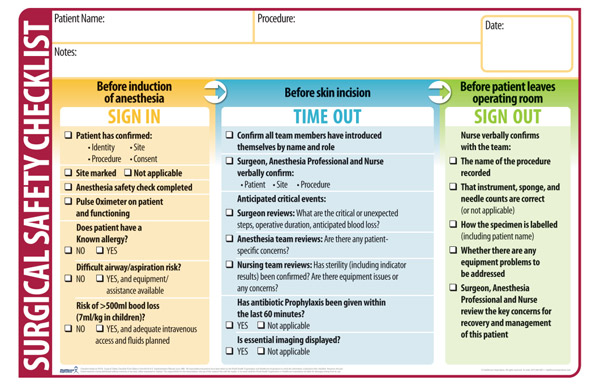
Patients experience fewer postoperative complications when a surgical safety checklist is used by their surgical team, reports the first large-scale review on the subject published in the June issue of Anesthesiology, the official medical journal of the American Society of Anesthesiologists® (ASA®). By following a simple checklist, health care providers can minimize the most common postoperative risks such as wound infection and blood loss.
“Our review represents the first comprehensive analysis of the effect of using surgical safety checklists on major postoperative complications,” said Brigid Gillespie, Ph.D., R.N., National Health & Medical Research Council and Griffith University, Queensland, Australia. “Although checklists are considered a best practice in surgery, there is still variability in adoption and compliance rates in their use. It is our hope that this review will provide more extensive evidence on the tremendous patient safety benefits that checklists offer and will lead to the consistent adoption of their use in surgery.”
Researchers examined seven independent, previously published studies that tested the effect surgical safety checklists had on postoperative complications. A meta-analysis was performed in which the results of the studies, representing 37,339 patients, were integrated. All patients had either elective or emergency surgery. In all of the studies, the World Health Organization’s (WHO’s) Surgical Safety Checklist or a modified version was used.
Researchers found that using a checklist in surgery significantly reduced overall postoperative complications, wound infections and blood loss. According to the review, there were 3.7 percent fewer postoperative complications overall (one complication prevented for every 27 patients when the checklist is used), 2.9 percent fewer wound infections (one less wound infection prevented for every 34 patients), and a 3.8 percent reduction in patients who had blood loss greater than 500ml (one less patient had blood loss greater than 500ml for every 33 patients). However, the use of a checklist did not significantly reduce mortality rates, pneumonia or unplanned return to the operating room (O.R.).
According to researchers, the review represents the best evidence available regarding the relationship between the use of surgical safety checklists and postoperative complications to date.
Since its introduction in 2009, the WHO Surgical Safety Checklist has been mandated in O.R.s in more than 122 countries. It is a patient safety tool used to ensure the safe delivery of anesthesia, prevent surgical errors and complications and promote effective teamwork and communication within surgical teams. The checklist identifies specific tasks that should be completed during three different phases of surgery — before anesthesia is administered, before skin incision, and before the patient leaves the O.R.
The study done by American Society of Anesthesiologists (ASA).